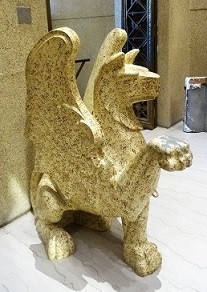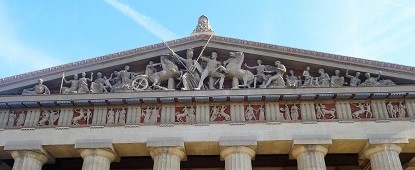


|
|
||||||||||||||||
|
|
||||||||||||||||
|
|
|||
|
|
Nashville Parthenon
During the Exposition it housed an art exhibition consisting of 1,171 items from all over the world. Due to its popularity and protests about is demolition following the close of the exposition, the building was left standing. Over time, the temporary nature of the construction led to the deterioration of the plaster and the crumbling of the pediments, so it was decided by the city authorities to authorise the reconstruction of the building of a more permanent nature using more robust materials. Instead of rebuilding the structure as it was for the Exposition it was decided to create an exact replica of the original temple as it stood in the Acropolis, both externally and internally. Although what had been the basement in the 1897 structure was to become gallery space for the exhibiting of fine art. The new building was completed in 1931 and opened to the public on 21 May 1931 attracting over 10,000 visitors from all over the country and from around the world in the first month. The structure enables those who are interested in the Parthenon in Athens to see what it would have originally looked like. Entrance is through the rear of the building at the lower level and leads to the exhibition.  Photographs are not permitted in the exhibition, although they may be taken when visitor ascend the stairs and enter the temple. The temple consists of two floors of Ionic columns around a rectangular hall with the statue of Athena at the far end. Athena was the Goddess of wisdom and warfare and was the patron deity of the city of Athens. The original statue in Athens was made of a wooden frame covered with ivory and gold and in fact cost as much to produce as the building itself. Unfortunately, it has not survived but it is known that it was constructed by Phidias and would have stood in the same position in the temple as the Nashville one stands 41 foot 10 inches tall from the floor to the top of her centre crest on her helmet. It is made of gypsum cement reinforced with fiberglass on a steel frame. It was commissioned in 1982 from the Nashville sculptor Alan LeQuire and was unveiled in May 1990. The gilding and painting was completed in 2002. In Athena’s right hand is a 6 foot 4 inches tall statute of Nike, the winged goddess of victory, while her left hand holds a shield.  During the period of reconstruction, the city of Nashville purchased a set of casts of the Parthenon pediments fragments which were used to create the pediments on the Nashville buildings. These fragments are now on display. These were taken from the Elgin Marbles which were removed from the Acropolis by the Earl of Elgin at the beginning of the 19th century. At each end of the pediment in the corner of the roof is a statue of a Gryphon.  Leading from the main hall at the side of Athena’s statue are a set of doors leading to the treasury. By their side stand two Gryphons as their function was to act as guardians of treasure and were known as the hounds of Zeus and protected a stream in the north of Greece that flowed with gold. The Gryphon had the head and wings of an eagle and body and tail of a lion. The ones on display are made from fibreglass. The bronze doors installed in 1930 are 24 feet high and 6.5 feet wide and weigh 7.5 tons. These are amongst the largest set of matching doors in the world. At the other end of the building is another set of doors which are a matching pair. The relief sculptures on the doors depict a ram, Medusa and a lion. The doors are perfectly balanced on a steel hinge and ball-bearing collars to allow them to be opened and closed easily. Whereas the Athens Parthenon was constructed in marble brought from Mount Pentilicon, 10 miles from Athens, the Nashville one is constructed of cast concrete aggregate. Externally, the east pediment, at the rear, depicts the birth of Athena and scenes associated with her birth. The west pediment, on the front façade, depicts the contest between Athena and Poseidon to determine which of them was to be the patron deity of Athens: A contest Athena won.  |
|
|
|
|
|||
All Photographs were taken by and are copyright of Ron Gatepain
| Site Map |